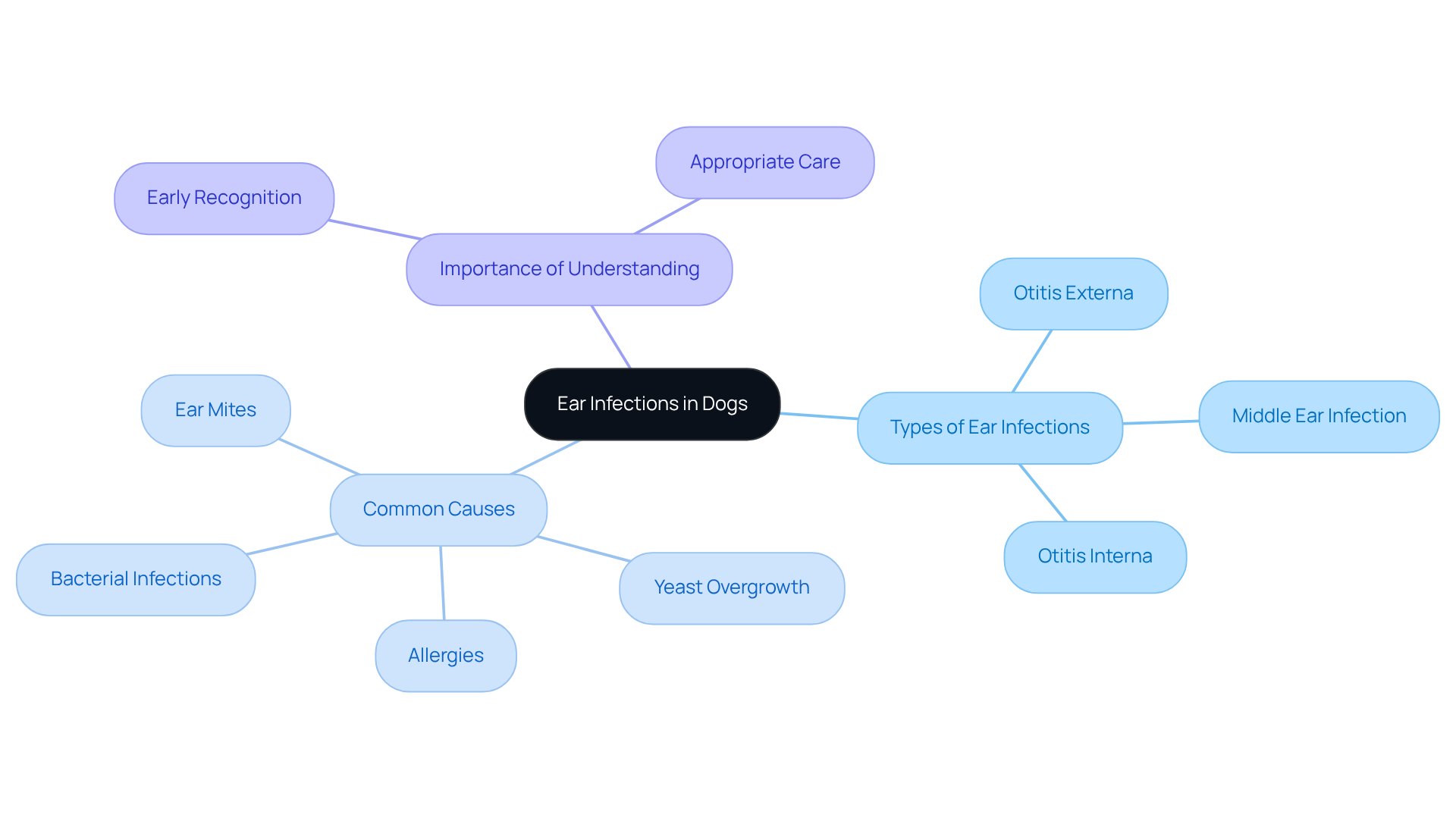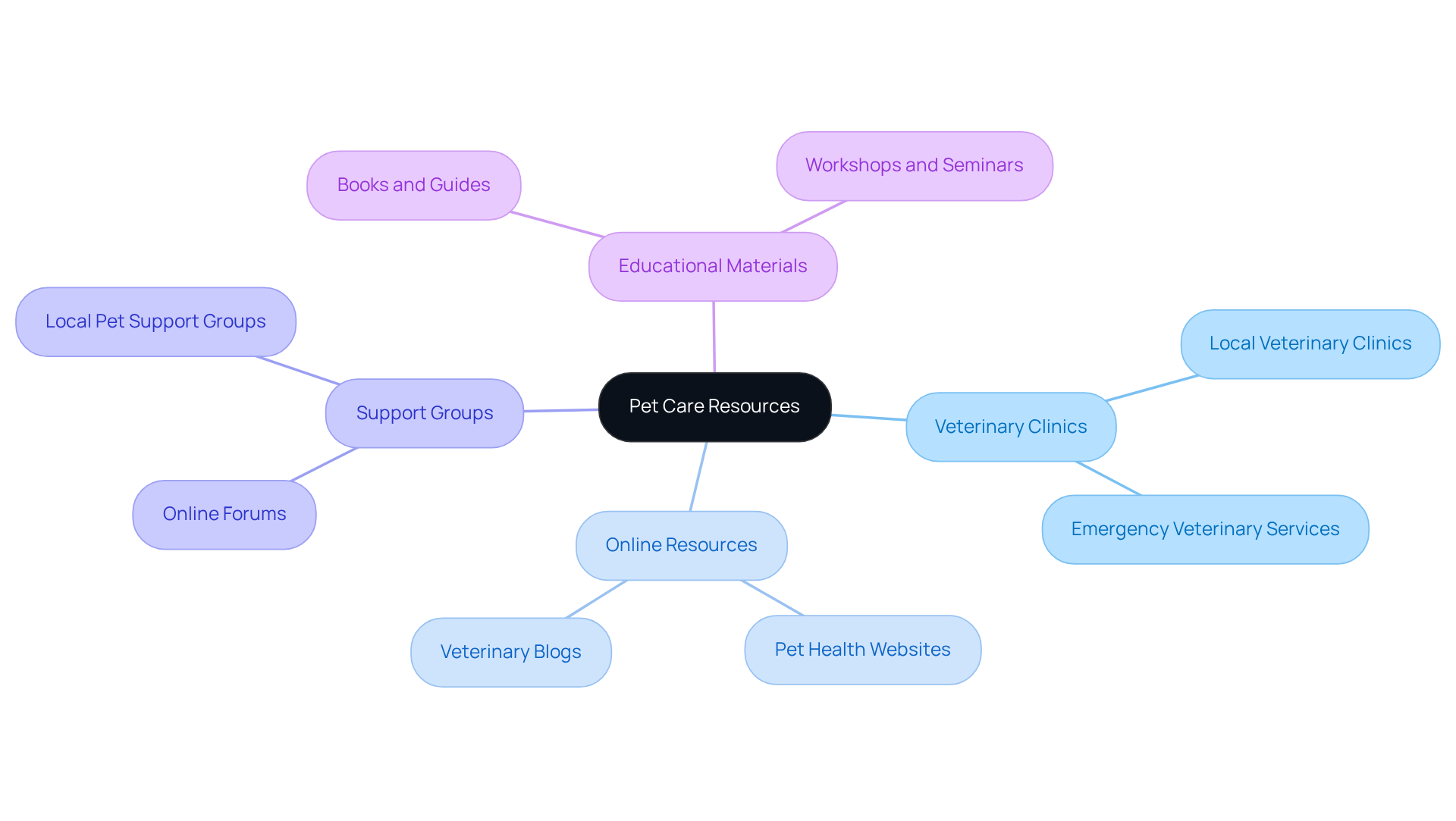Ear Infection Dog: Recognize Symptoms and Effective Treatments
Overview
Ear infections in dogs, especially otitis externa, are a common concern for pet owners. These infections can stem from various causes, including:
- Bacteria
- Yeast
- Allergies
- Foreign objects
It’s essential to recognize symptoms early, such as head shaking and discharge, as this can significantly affect your furry family members’ comfort and health.
At Adventure Den, we understand how distressing it can be to see your beloved pet in discomfort. That’s why we emphasize effective treatments that include both veterinary care and at-home management. Taking timely action can prevent complications and ensure your pet receives the nurturing environment they deserve.
If you notice any signs of ear infections, please don’t hesitate to reach out for help. Your pet’s well-being is our priority, and we are here to provide the compassionate care they need.
Introduction
Understanding ear infections in dogs is essential for every pet owner. These common ailments can lead to serious health complications if left untreated, and we know how much you care about your furry family members. This guide explores the symptoms, causes, and effective treatments for ear infections, empowering you to recognize early signs and take proactive measures.
Have you ever wondered what happens when a seemingly minor issue escalates into a chronic condition? By delving into the intricacies of canine ear health, you’ll uncover the essential knowledge needed to safeguard your beloved companions’ well-being.
Understand Ear Infections in Dogs
Ear issues, such as an ear infection dog, are quite common and can stem from several factors, including bacteria, yeast, allergies, and foreign objects. One of the most frequent types of ear infection in a dog is otitis externa, which affects the outer ear canal. Understanding the structure of a dog’s ear is essential, particularly for breeds with droopy ears, as they are more prone to ear infection dog issues caused by moisture accumulation. It’s important to recognize the underlying causes, such as allergies or ear mites, to ensure effective treatment and prevention of an ear infection dog. Regular ear cleansing and observation can play a significant role in maintaining ear health and preventing complications, especially in cases of ear infection in dogs.
Types of Ear Infections
- Otitis Externa: This is inflammation of the outer ear canal, often caused by bacteria or yeast.
- Ear infection dog: This infection of the middle ear can occur if otitis externa is left untreated.
- Otitis Interna: An ear infection dog can lead to more severe complications if not addressed promptly.
Common Causes
- Bacterial Infections: Often caused by Staphylococcus or Pseudomonas bacteria.
- Ear infection dog: This condition is typically due to an overgrowth of Malassezia yeast.
- Allergies: Environmental or food allergies can lead to inflammation, which may result in an ear infection in dogs and subsequent complications.
- Ear Infection Dog: Particularly in puppies, these parasites can cause significant irritation and lead to an ear infection.
Importance of Understanding Ear Infections
Recognizing the signs and symptoms early can prevent more serious health issues and ensure your furry family member receives the appropriate care in a timely manner. This foundational knowledge is essential for any dog owner seeking to effectively manage their pet’s health, particularly in relation to an ear infection dog. At Adventure Den, we are here to support you and your beloved pet, ensuring a nurturing environment for their well-being.

Recognize Symptoms of Ear Infections
Identifying the signs of ear infection in your dog is crucial for timely intervention. As a caring pet owner, it’s important to recognize these common signs:
- Head Shaking: Your dog may shake their head frequently to relieve discomfort.
- Scratching or Pawing at the Ear: This behavior may indicate an ear infection in a dog or irritation or pain in the ear area.
- Redness and Swelling: An ear infection dog might display an inflamed and red ear canal.
- Odor: A foul smell, often described as yeasty or similar to corn chips, can indicate an ear infection in a dog.
- Discharge: Look for dark, yellow, or bloody discharge from the ear, as this could signal an ear infection in a dog.
- Loss of Balance: In severe situations, illnesses can impact your dog’s equilibrium due to an ear infection dog.
- Behavioral Changes: Increased irritability or lethargy may also be observed in a dog with an ear infection.
Recognizing these symptoms promptly can lead to quicker treatment for an ear infection dog, which reduces the risk of complications such as hearing loss or chronic infections. If you notice any of these signs related to an ear infection dog, we encourage you to consult a veterinarian for a thorough examination. Your pet deserves the best care, and taking action can make a significant difference in their well-being.

Treat Ear Infections Effectively
Addressing an ear infection in a dog often requires a thoughtful blend of veterinary care and at-home management. We understand how concerning it can be when your furry family member is unwell. Here’s a gentle guide to help you navigate this process:
Veterinary Treatment
- Consult a Veterinarian: If you suspect an ear issue, it’s important to schedule an appointment for a thorough examination. Your vet is here to help.
- Diagnosis: The vet will inspect the ear canal with an otoscope and may collect samples to determine the type of ailment affecting your dog.
- Cleaning: The veterinarian will clean the ear canal, removing debris and discharge, which is crucial for effective treatment and your pet’s comfort.
- Medications: Depending on the diagnosis, your vet may prescribe:
- Topical Antibiotics: To combat bacterial infections.
- Antifungal Medications: For yeast conditions.
- Anti-inflammatory Drugs: To reduce swelling and pain.
- Oral Medications: In severe cases, oral antibiotics may be necessary to ensure a swift recovery.
At-Home Care
- Follow Veterinary Instructions: Administer medications as prescribed and follow up with your vet as needed. Your diligence makes a difference.
- Regular Ear Cleaning: Utilize a vet-recommended ear cleaner to uphold ear hygiene and avoid future issues, ensuring your dog stays happy and healthy.
- Monitor Symptoms: Keep an eye on your dog’s behavior and ear condition, reporting any changes to your vet. Your observations are invaluable.
Preventive Measures
- Regular Ear Checks: Inspect your dog’s ears regularly for signs of infection. A little attention goes a long way.
- Keep Ears Dry: After baths or swimming, ensure your dog’s ears are dried thoroughly to prevent moisture buildup.
- Manage Allergies: Collaborate with your veterinarian to tackle any underlying allergies that may lead to ear problems. Together, you can create a nurturing environment for your pet.
By following these steps, you can effectively treat and manage ear infection in your dog, ensuring a swift recovery and preventing future occurrences. Remember, you’re not alone in this; your veterinary team is here to support you and your furry family member every step of the way.

Access Resources and Support for Pet Care
Accessing the right resources and support can significantly enhance your ability to care for your furry family member, especially if they have an ear infection dog. Here are some valuable resources to consider:
Veterinary Clinics
- Local Veterinary Clinics: Establish a caring relationship with a trusted veterinarian who can provide ongoing care and compassionate advice.
- Emergency Veterinary Services: It’s essential to know the location of emergency clinics for those urgent situations that may arise.
Online Resources
- Pet Health Websites: Websites like PetMD and the Merck Veterinary Manual offer comprehensive information on ear infections and other important pet health topics.
- Veterinary Blogs: Following trustworthy veterinary blogs can provide you with tips and insights on managing your pet’s health effectively.
Support Groups
- Online Forums: Joining pet owner forums or social media groups allows you to share experiences and seek advice from fellow dog owners who understand your journey.
- Local Pet Support Groups: Engaging with local pet support groups can provide you with assistance and valuable suggestions tailored to your community.
Educational Materials
- Books and Guides: Consider reading books on canine health and behavior to deepen your understanding of your dog’s needs and well-being.
- Workshops and Seminars: Attending workshops or seminars on pet management offers a wonderful opportunity to learn from specialists in the field.
By utilizing these resources, you can enhance your knowledge and skills in managing your ear infection dog, ensuring they receive the best possible care in a nurturing environment.

Conclusion
Recognizing and addressing ear infections in dogs is essential for ensuring their overall health and well-being. By understanding the various types of ear infections, their causes, and the symptoms to look out for, dog owners can take proactive steps to prevent and treat these common issues. This knowledge not only empowers pet owners but also fosters a deeper bond with their furry family members as they become more attuned to their needs.
The importance of timely intervention and effective treatment cannot be overstated. Identifying symptoms like head shaking and foul odors, seeking veterinary care, and implementing at-home management strategies are crucial steps in preventing complications such as chronic infections or hearing loss. Additionally, utilizing available resources, including veterinary clinics and online support groups, can enhance a pet owner’s ability to provide the best care possible.
Ultimately, staying informed about ear infections in dogs is not just about managing a health concern; it is about ensuring a happy and healthy life for your beloved pets. By prioritizing ear health and taking action at the first signs of trouble, pet owners can make a significant difference in their dog’s quality of life. Embrace the responsibility of being a pet owner by learning and applying this knowledge for the well-being of your furry companions.
Frequently Asked Questions
What are the common types of ear infections in dogs?
The common types of ear infections in dogs include otitis externa, which is inflammation of the outer ear canal, and ear infections of the middle ear and otitis interna, which can lead to more severe complications if not treated promptly.
What causes ear infections in dogs?
Ear infections in dogs can be caused by several factors, including bacterial infections (often from Staphylococcus or Pseudomonas bacteria), an overgrowth of Malassezia yeast, allergies (environmental or food), and parasites, particularly in puppies.
Why are some dog breeds more prone to ear infections?
Breeds with droopy ears are more prone to ear infections due to moisture accumulation, which can create an environment conducive to infections.
How can I recognize if my dog has an ear infection?
Recognizing the signs and symptoms of ear infections early is crucial. Common signs may include scratching at the ears, shaking the head, foul odor, redness, or discharge from the ear.
What role does regular ear cleansing play in dog ear health?
Regular ear cleansing and observation can help maintain ear health and prevent complications, particularly in preventing ear infections in dogs.
How can allergies lead to ear infections in dogs?
Environmental or food allergies can cause inflammation in a dog’s ears, which may result in an ear infection if not addressed.
What should I do if I suspect my dog has an ear infection?
If you suspect your dog has an ear infection, it is important to seek veterinary care for appropriate diagnosis and treatment to prevent more serious health issues.



